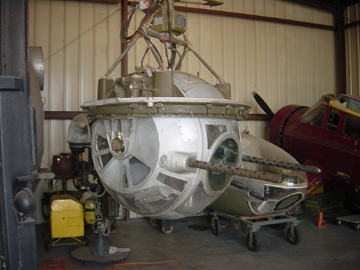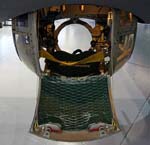The Sperry Ball Turret is a defense weapon used on B-17 Flying Fortress and B-24 Liberator bombers during World War II. Randall Jarrell's poem "Death of the Ball Turret Gunner" famously features these weapons.
The turret was used to protect the vulnerable underside of the airplane. It had to be very small in order to create the least amount of drag feasible. This made the interior of the ball extremely cramped, and indeed, the RAF considered it impossible to stay in the ball turret for an entire mission when they were first analyzing the plane, but gunners regularly spent 8-10 hours in the ball. The turret gunner was the smallest man on the bomber crew, and surprisingly, post-war analysis of crew fatality records indicate that the turret gunner was the safest job on the aircraft (the pilot's job was the most dangerous.)
The turret was built by the Sperry Corporation, and it had 2 .50 machine guns with 250 rounds of ammunition apiece. The ball was electrically powered, but also had a hand crank to rotate the ball to get out without power. Inside the ball was a first aid kit, a gunsight, the turret controls, interior lighting, breathing oxygen regulators, and a radio. There was also a plug to plug in an electrically heated flightsuit, because the inside of the ball turret was freezing at high altitudes, especially in the winter.
The gunner usually did not enter the ball until the plane was in flight, because of the possibility of landing gear failure, and the possibility of being crushed. On the ground, the ball was only 15 inches from the ground. The ball was inaccessible from the inside of the airplane while on the ground, because the hatch to get in was on the opposite side from where the guns were, and they would hit the ground first. It was possible to enter from outside the plane by rotating the hatch toward the outside, but then the gunner would have to stay there during takeoff.
Two post handles worked to control the ball like joysticks, and each stick had a button to fire the guns. and the left foot controlled the gunsight, while the right foot operated a push-to-talk intercom switch to communicate with the rest of the crew.



No comments:
Post a Comment